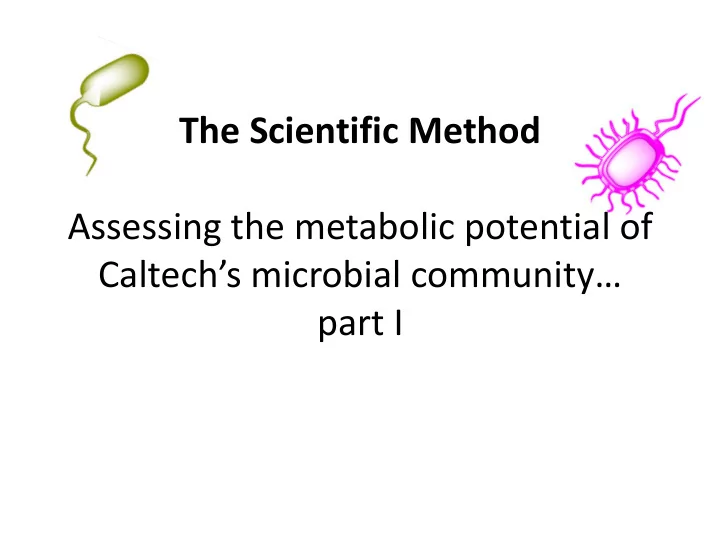

The Scientific Method Assessing the metabolic potential of Caltech’s microbial community… part I
Metagenomic and functional analysis of hindgut microbiota of a wood-feeding higher termite
The Terms of Metagenomics Metagenomes – genetic material recovered directly from environmental samples Metagenomics – the study of metagenomes • Clone specific genes (16S rRNA gene) to produce a profile of diversity in a natural sample • Sequence to get largely unbiased samples of all genes from all the members of the sampled communities • Use bioinformatics to analyze the data
What is Bioinformatics? The application of computer science to the field of biology
The Algorithms Phrap – used for DNA sequence assembly FgenesB – ab initio gene prediction engine BLAST – finds regions of local similarities between sequences and aligns them Pfam – collection of protein families and analysis tools PHYLIP – infers evolutionary trees (phylogenies)
Pfam Demo http://pfam.sanger.ac.uk/ MAHGCSGGAMSRFVFLGVALALLGGATSPAAAAPRVTPVVVDVDDYGADPTGRTDSTPAVAAALRHAKSVDRPVRIVF SKGTYQLYPERAETRELYMSNTVGADQRYRDKKIGLLVEDMHDVTVDGGGAKLVHHGLQTAFASIRSTDVTFQNFSFDYA APEVIDATVATTGVTDGHAYRVLKIPAGSPYRVNGTHITWLGETSPATGQPYWSGVDGLQYTQIHDPEAQRTWRGDNPL FNDVAAVTDLGGRRIRIDYTTAARPADAGLVYQMRLIERTEPGAFIWESKNVTMRSMNAYYLQSFGVVGQFSENISIDKV NFAPDPRSGRSTASFADFVQMSGVKGKVSITRSLFDGPHDDPINIHGTYLEVVGKPGPSTLTLAYKHPQTAGFPQFAPGD EVEFATKRTMTPLADAHAQVTAVDGPSGMDHTKPLTTMTVTFDRPVPAGVETGGTVVENITATPSVVISGNVFRNVPTR GILVTTRKPVLITGNRFDGMSMASIYVSADAYQWYESGPVADLTIRGNSFTRPSGPVIFVEPTNQVIDPATPVHHNISVEH NSFDIGDVTVVNAKSVGGFAFT GNTVRRLDGADHPPYTSPLFVFHGSSGIRIARNHYDKGLNTSVVTD
The Scientific Method A body of techniques for investigating phenomena, acquiring new knowledge, or correcting and integrating previous knowledge Four essential elements: 1. Characterizations – observations, definitions of subject of inquiry 2. Hypotheses — theoretical, hypothetical explanations 3. Predictions — reasoning 4. Experiments — testing all of the above
The Volta Experiment 1. Characterizations of flaming pond 2. Hypotheses 3. Predictions 4. Experiments
Ponds produce methane gas Methanogenisis Interpret data of life in the and draw pond created conclusions the gas Isolate and Microorganisms identify living in the pond organisms based may produce methane during on what they metabolism metabolize
Metabolic potential of Caltech’s ponds Mini Lab
Turtle Ponds Determine most diverse Metabolic Collect Monitor the plate and assay of the sample from plates to collect sample and a pond and track colony another isolates from plate it growth sample from the plate that location The section that locates the most metabolically active location on campus will receive a fabulous prize!!! Baxter Pond BBB Pond
Sample the environment! Week 4 • Isolate a sample of pond water for a representative microbial population – Baxter, BBB, turtle ponds • Plate serial dilutions pond water on 1% TSB agar plates – Trypticase Soy Broth (TSB) • Incubate plates to allow colonies to grow – One week of growth time at room temperature – Check on their growth during the week
Biolog Metabolic Assay Week 5 • Different populations of microbes may utilize different carbon sources • Identifying which carbon sources can be used can allow for identification • 96-well plate format allows for the simultaneous testing of 95 different carbon sources at one time • If cells proliferate on a certain well, they are able to metabolize the carbon source
Week 4: 10 0 10 -1 10 -2 10 0 10 -3 10 -1 10 -2 10 -3 Incubate for one week at room temperature Week 5: As a section, choose which location you think Week 6: has the greatest Baxter metabolic potential BBB Turtle pond Indicator Individual dye isolates
Click on Sequence Search
2. Click ‘Go’ 1. Paste your sequence in the box
Click on the family name you want
Click on Species
Click on Tree Tab
Use the species , sequences , and regions numbers to interpret tree
Recommend
More recommend